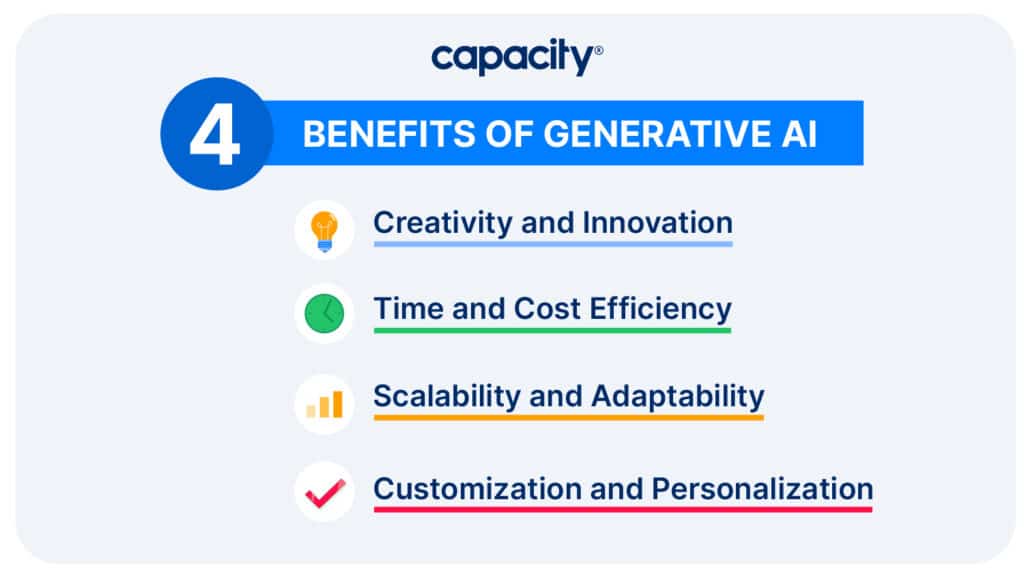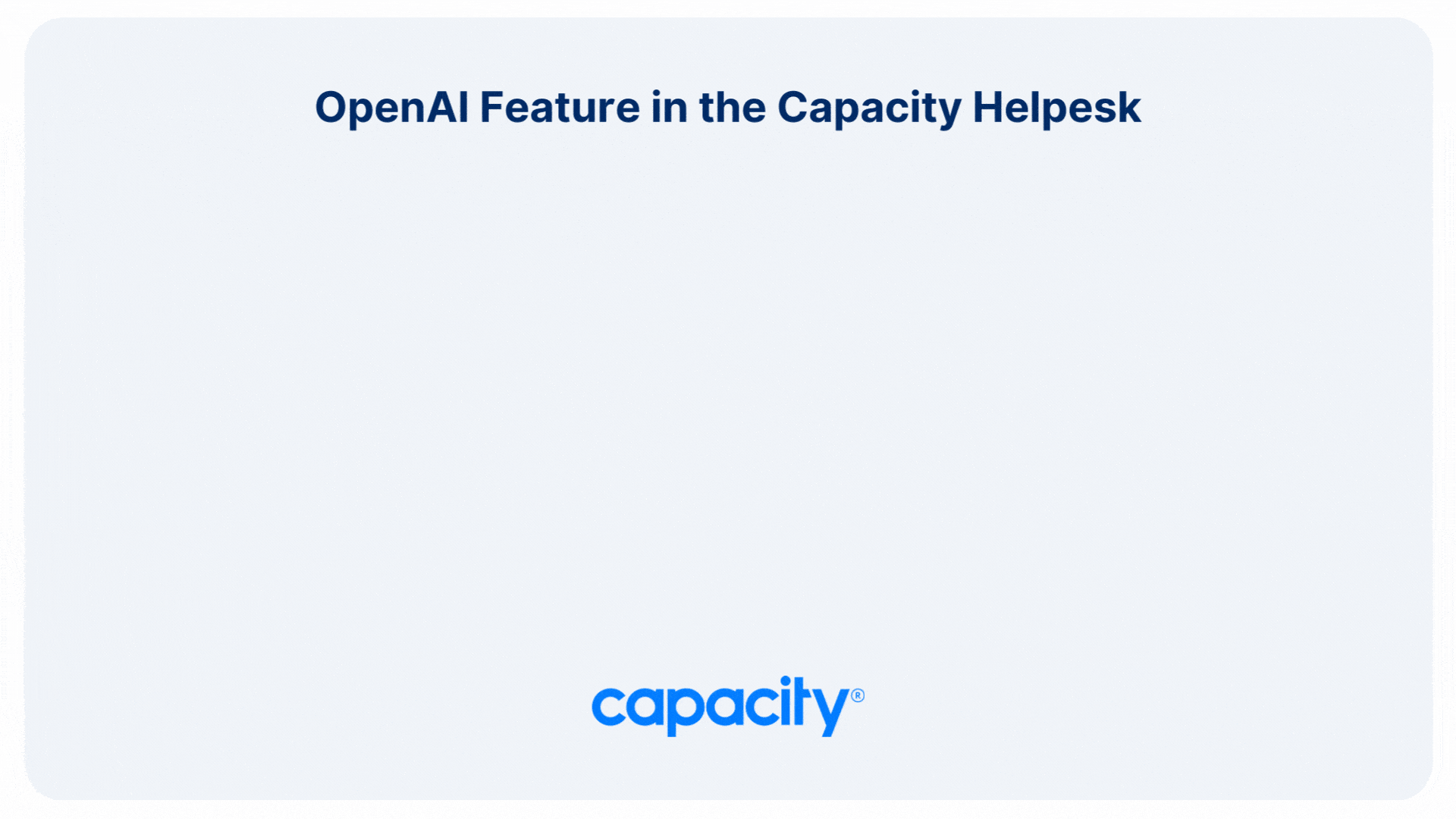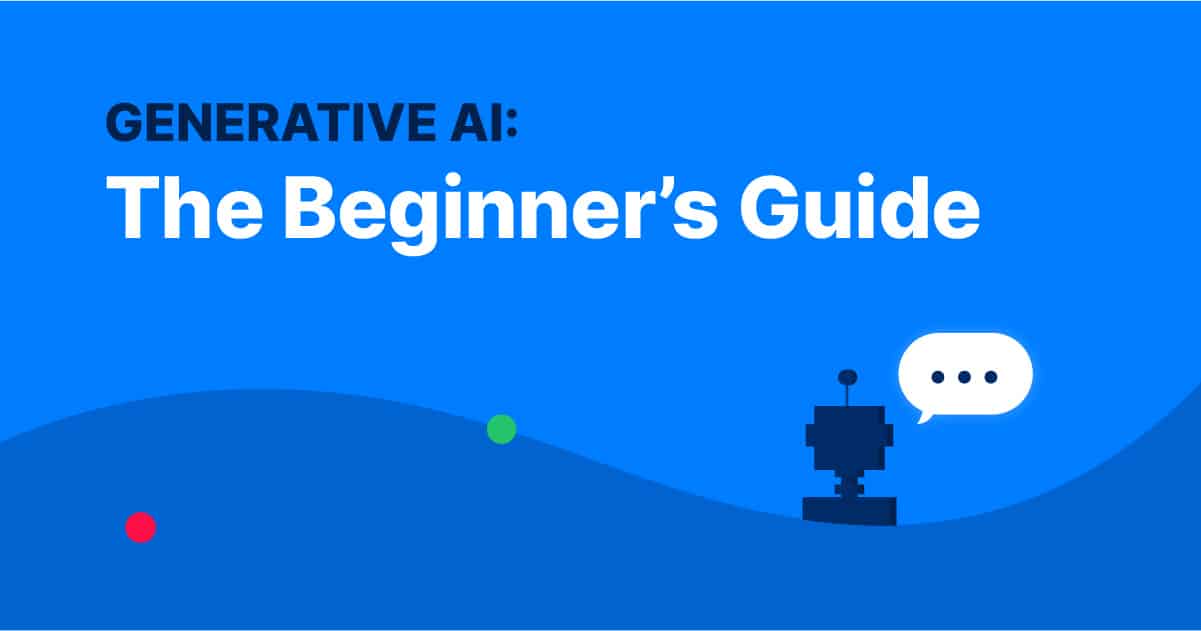Artificial Intelligence (AI) has been revolutionizing various industries, and one of its rapidly growing fields is generative AI. It’s a type of AI technology that can generate original content such as images, music, text, and even entire virtual worlds. In this article, we will explore generative AI’s benefits, how it can help businesses, and how it differs from AI chatbots.
Let’s dive in!

Automate Your Work
Capacity’s enterprise AI chatbot can help:
- Answer FAQs anytime, anywhere
- Find relevant documents within seconds
- Give surveys and collect feedback
What is Generative AI?
Generative AI, or generative artificial intelligence, is a branch of AI that involves using algorithms and models to create new and original content.
This type of AI can generate content that is not copied or replicated from existing data but produces something entirely new.

How does generative AI work?
Generative AI works by training on large datasets, including images, text, audio, or any other form of data, and then uses that training data to generate new content. It uses machine learning techniques such as deep learning, neural networks, and reinforcement learning to learn patterns, structures, and features from the training data and then uses that knowledge to create new content.

Benefits of Generative AI
Generative AI offers several benefits across different industries, making it a promising technology with wide-ranging applications. Some of the key benefits include the following:
Creativity and Innovation
Generative AI can generate new and original content, allowing for creative and innovative solutions.
For example, it can create unique and original artworks, logos, and graphics in art and design, helping artists and designers explore new creative possibilities.
Time and Cost Efficiency
Generative AI can save time and costs by automating content generation processes.
For instance, it can automatically generate personalized advertisements, social media posts, and other marketing materials in advertising and marketing, reducing the need for manual content creation and saving time and resources.
Scalability and Adaptability
Generative AI can easily adapt to changing requirements and scale to handle large volumes of content generation tasks.
This makes it suitable for industries with dynamic content creation needs, such as agencies, customer support organizations, and entertainment companies.
Customization and Personalization
Generative AI can create content tailored to individual preferences and needs, leading to highly customized and personalized experiences.
For example, in eCommerce, generative AI can generate personalized product recommendations, virtual try-on experiences, and personalized shopping experiences, enhancing customer engagement and satisfaction.

How Can Generative AI Help Businesses?
Generative AI has the potential to revolutionize various industries and provide businesses with new opportunities and competitive advantages. Some of the advantages include:
Product Design and Development
Generative AI can aid in the design and development of new products. For example, in the automotive industry, it can generate 3D models of car designs based on specific requirements, helping engineers and designers to explore different design options and optimize the design process.
Content Creation and Marketing
Generative AI can automate content creation tasks, making it easier and more efficient for businesses to generate marketing materials such as social media posts, blogs, and advertisements. This can save time and resources while allowing for customization and personalization, leading to more engaging and effective marketing campaigns.
Virtual Reality and Gaming
Generative AI can create virtual worlds, characters, and objects in virtual reality and gaming. This can enhance the immersive experience for users and enable developers to create unique and dynamic virtual environments.
Healthcare and Pharmaceuticals
Generative AI can assist in drug discovery by generating new chemical compounds and predicting their properties. This can accelerate the drug development process and lead to the discovery of new treatments and therapies for various diseases.
Fashion and Design
Generative AI can aid the fashion and design industry by generating unique clothing designs, patterns, and textiles. This can help designers develop innovative and personalized fashion collections and streamline the design process.
Entertainment and Media
Generative AI can create original music, art, and other forms of media. This can be used in the entertainment industry to produce unique content, enhance virtual reality experiences, and create interactive media experiences.
Data Visualization and Analysis
Generative AI can create visual representations of complex data sets, making it easier for businesses to analyze and understand the data. This can aid in decision-making, forecasting, and identifying patterns and trends in data.
Generative AI vs AI Chatbots
Generative AI and intelligent chatbots are two distinct types of AI technologies, although they share some similarities.
AI chatbots
AI chatbots are designed to engage in conversations with users and provide responses based on predefined rules or scripts. They are typically used for customer service, support, and information retrieval.
Generative AI
On the other hand, generative AI focuses on creating original content and does not rely on predefined rules or scripts. It can generate new and unique content based on patterns learned from training data, while AI chatbots rely on pre-programmed responses.
Generative AI focuses more on content creation and creativity, while AI chatbots focus more on communication and interaction.
Verdict
Both generative AI and intelligent chatbots have their strengths and applications. Generative AI is ideal for industries that require creativity, innovation, and content generation, such as art, design, fashion, and entertainment.
On the other hand, AI chatbots are suitable for industries that require customer engagement, support, and information retrieval, such as customer service, eCommerce, and online assistance.

How to Configure Generative AI in Your Business?
Generative AI has the potential to revolutionize businesses across various industries by enabling them to create unique and personalized content, automate repetitive tasks, and generate new ideas. Here are some steps to configure it in your business:
Choose the Right Generative AI Tools
Numerous AI tools and platforms are available. Research options based on your business requirements, budget, and technical expertise.
Data Collection and Preparation
Generative AI models require large amounts of data for training. Collect and prepare relevant data sets that align with your business use case. Ensure that the data is clean, diverse, and representative of the content you want to generate.
Data preparation may involve cleaning, transforming, and augmenting data to ensure its quality and suitability for training generative AI models.

Automate Your Work
Capacity’s enterprise AI chatbot can help:
- Answer FAQs anytime, anywhere
- Find relevant documents within seconds
- Give surveys and collect feedback
Model Training and Optimization
Once you have collected and prepared the data, you can train your generative AI models. This involves feeding the data into the AI tool and training the model using appropriate algorithms and techniques.
Experiment with different hyperparameters, architectures, and training settings to optimize the performance of your models. Training generative AI models can be computationally intensive, so be prepared to allocate sufficient computing resources for this process.
Deployment and Integration
Once you are satisfied with the performance of your generative AI models, it’s time to deploy them in your business environment.
This may involve integrating the generative AI models with your existing systems, such as websites, mobile apps, or chatbots.
Ensure the seamless integration aligns with your business requirements and user experiences.
Staff Training and Education
Configuring generative AI in your business may require training and education for your staff. Provide appropriate training and resources to your team members to familiarize them with AI concepts, tools, and processes.
Encourage continuous learning and skill development to harness the full potential of generative AI in your business.
Generative AI Tools
Businesses and developers can use several AI tools and frameworks to create their own applications. Some popular AI tools include:
- GANs (Generative Adversarial Networks): GANs are a type of model that involves two neural networks, a generator, and a discriminator, that are trained together in adversarial training. GANs have been widely used for generating images, videos, and other forms of content.
- Variational Autoencoders (VAEs): VAEs are another model for generating images, videos, and other content. VAEs work by learning a probabilistic mapping between the input data and a latent space and developing new data samples from the latent area.
- DeepDream: DeepDream is a popular tool developed by Google that uses neural networks to create artistic and psychedelic images. DeepDream has been used in art and design to create unique and visually stunning artworks.
- TextGAN: TextGAN is a tool that generates text-based content, such as stories, poems, and articles. TextGAN uses GANs and other techniques to create coherent and contextually relevant text based on the training data.
What is the Best Generative AI Tool?
Capacity is an AI-powered support automation platform offering many features and capabilities, making it a strong contender as one of the best AI tools for customer support teams.
Capacity’s Helpdesk has an API with OpenAI, allowing conversational AI technology to suggest and improve responses, summarize lengthy support tickets, and relevant list action items.

Here are some other reasons why Capacity stands out:
- Comprehensive Platform – Capacity provides a comprehensive platform that connects your entire tech stack to answer questions, automate repetitive support tasks, and build solutions to any business challenge.
- Knowledge Base – Capacity empowers employees to access information through a user-friendly knowledge base.
- Developer Platform – Capacity’s robust developer platform allows businesses to customize and extend their capabilities, making it a flexible tool that can adapt to unique business needs.
Most businesses spend $100 or more per hour on customer support. Capacity saves support teams time and money.
So what are you waiting for? Check out Capacity today!





